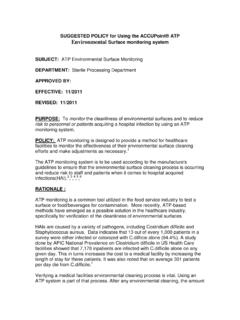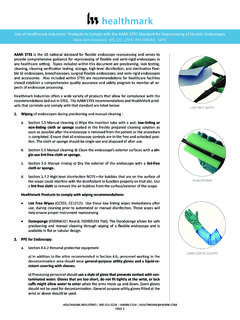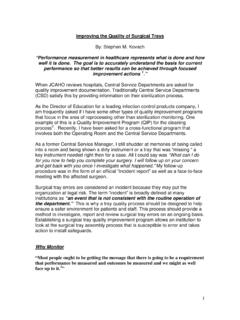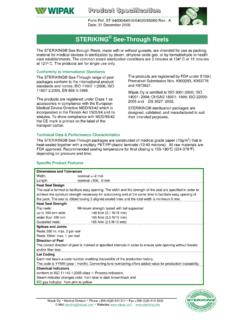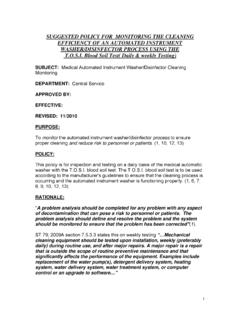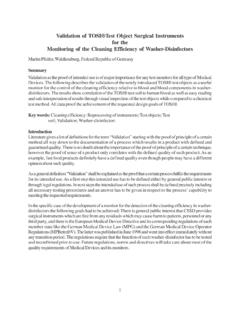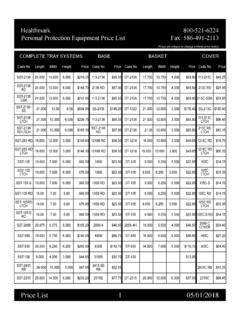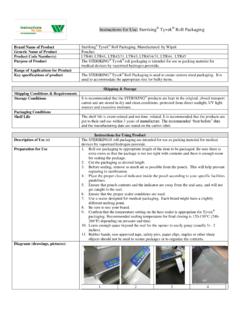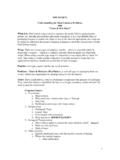Transcription of SUGGESTED POLICY FOR TEMPERATURE MONITORING OF …
1 SUGGESTED POLICY FOR TEMPERATURE MONITORING OF AN automated INSTRUMENT washer / disinfector process USING THE The TempaChekDL SUBJECT: TEMPERATURE MONITORING of the automated Instrument washer / disinfector DEPARTMENT: Central Service APPROVED BY: EFFECTIVE: REVISED: 06/07 PURPOSE: To monitor the TEMPERATURE of automated instrument washer / disinfector process to ensure proper cleaning and reduce risk to personnel or patients. POLICY : To perform daily the testing of the various stages of the TEMPERATURE within a medical automatic washer RATIONALE: Cleaning, not sterilization (or disinfection), is the first and most important step in any instrument processing protocol. Without first subjecting the instrument to a thorough, validated and standardized (and ideally automated ) cleaning process , the likelihood that any disinfection or sterilization process will be effective is significantly reduced. Washers fail to clean for many reasons.
2 TEMPERATURE is one of the reasons. The TempaChekDL provides a means of MONITORING the TEMPERATURE at various stages within the automatic washer that influence the effectiveness of a washer . Proper cleaning is critical. The TempaChekDL provides an independent objective test of the TEMPERATURE and allows the Sterile Processing professional to monitor and ensure proper cleaning in the automated instrument washer / disinfector process concerning TEMPERATURE . The TempaChekDL is the first device to bring data logging capabilities to the reprocessing equipment used by Central Sterile Processing Departments. This includes the cart washer , the ultrasonic and the automated instrument washer . With the later, it is now possible to verify thermal disinfection TEMPERATURE and time, because the TempaChekDL can record TEMPERATURE data as frequently as every second. The TempaChekDL is accurate to within 1 degree Fahrenheit. It is made of stainless steel, just like most surgical instruments and its resistivity TEMPERATURE sensor reacts nearly instantaneously to TEMPERATURE changes.
3 JCAHO and AAMI both recommend that Sterile Processing departments have process performance in place. Using the TempaChekDL test according to the manufacturer's guidelines helps ensure adherence to both JCAHO and AAMI standards and thus a properly functioning cleaning process when it involves TEMPERATURE . PROCEDURE: "A problem analysis should be completed for any problem with any aspect of decontamination that can pose a risk to personnel or patients. The problem analysis should define and resolve the problem and the system should be monitored to ensure that the problem has been corrected.) Daily TEMPERATURE Testing Follow manufacture guidelines concerning the daily inspection of equipment (spray arms, ) Bring to the attention any concerns on the equipment that the inspection revealed to the proper person in the department to address. The TempaChekDL can be run with other cleaning verification test.
4 Placing the TempaChekDL in the Decontamination Equipment The TempaChekDL data logger is water proof, but it is small, so in order to use in a washer , it is a good idea to contain it in a small covered container. (Figure1). If the basket has a lid (top) make sure you secure the lid after you place the TempaChekDL into the basket. Placement in the washer is an important consideration. It really depends on the objective of your testing. If you want to test the absolute capabilities of your washer , you might place the device out toward the very furthest point from the center of the spinner arms. If you are using a small basket, you may need to place the small basket in a larger, uncovered basket (see Figure 1). Load the rack, and run the washer on your normal instrument cycle, running in an empty washer . The TempaChekDL can also be used in other decontamation equipment, including the cart washer and the ultrasonic cleaning. Follow similar procedures as with testing the instrument washer .
5 Figure 1 TempaChekDL Data LoggerSuggested TEMPERATURE Range Pre -wash TEMPERATURE should not exceed 110 degrees F. Enzymatic stage TEMPERATURE should not excide 140degrees F 9 check with your detergent manufacture for the optimum TEMPERATURE range of your product Detergent stage is usually at 150 to 160 degrees F check with your manufacture of your detergent for the optimum range for your product Thermal Disinfections should be at 180 degrees F for at least 1 minute Caution should be used after the cycle because the TempaChekDL might be hot let cool for a few minutes After the cycle is finished follow directions on how to down load data into your departmental computer. Since computers are different at each medical facility refer to your specific medical facility POLICY on downloading the data into your computer. Generic directions can be found on the web at this link Download data by securing the TempaChekDL data logger into the USB Adapter Reader (Figure 2).
6 The USB Adapter is hooked up to your hospital computer. Record results on log sheet. Report any deviation from targeted TEMPERATURE . Note: Each medical automatic washer has their own set of TEMPERATURE ranges for each stage of cleaning; consult the manufactures for the optimum TEMPERATURE range for your equipment. USB Adapter Reader Cord TempaChekDL Data Logger Figure 2 Maintenance on Equipment After any maintenance on the equipment, perform TEMPERATURE test using the TempaChekDL to ensure that the equipment is reaching the proper TEMPERATURE at all stages. Have the maintenance person wait until the test results are complete before leaving. RESPONSIBILITY: Central Service personnel are responsible for the proper use, result interpretation, and documentation of the TempaChekDL when used on an automated instrument washer . Staff in-service and training on the equipment and proper use of the TempCheck DL should be done at least once each year.
7 REFERENCES: 1. 2. 3. 4. 5. 6. 510(k) Summary and Overview; Safety, Efficacy and Microbiological Considerations,. The System 83 plus washer - disinfector ; Custom Ultrasonic, Inc,1998, page 7. 7. ANSI /AAMI ST 79 2006 8. JCAHO Guidelines 2005 9. ANSI/AAMI TIR 12-2005 10. Managing Infection Control; Role of TEMPERATURE in Cleaning; Basile 2003 11.
